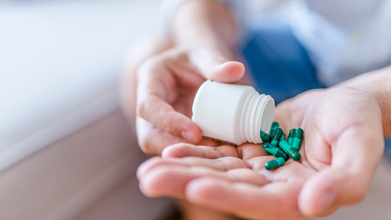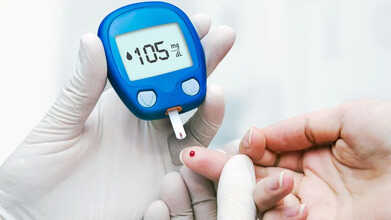- Health Conditions A-Z
- Health & Wellness
- Nutrition
- Fitness
- Health News
- Ayurveda
- Videos
- Medicine A-Z
- Parenting
World Brain Day 2025: Could Your Brain Heal Itself? Why Scientists Are Betting On Neuroplasticity To Treat Neurological Disorders

Credits: Health and me
There's a remarkable change taking place within your brain every single day and chances are, you don't even realize it. Every time you overcome a bad habit, acquire a new skill, or have a new idea, your brain remaps itself. This isn't poetic, it's science and it is called neuroplasticity.
For decades, scientists thought the adult brain was static, hardwired after childhood but over the last few decades, that's been completely rewritten by futuristic science. Today we know that the brain is dynamic, a changing entity that continues to adapt throughout life. Whether you're healing from trauma, creating new habits, or attempting to hone focus, your brain has the capacity to change—structurally and functionally.
What makes it even more intriguing is the way all this occurs unseen, as if a sculptor is working quietly, remolding clay with every experience, feeling, and deed. Neurons are reconfigured, synapses grow or dissolve. Large areas of the brain expand or contract based upon usage.
You're not tied to the brain you were born with. Neuroplasticity is possibility, and opening it up doesn't involve miracle tablets—it takes regular, conscious effort. From mindfulness exercises to movement and mindset changes, tiny habits can result in huge rewiring. Let's see how it works—and what it might do for your mental health.
What Is Neuroplasticity?
Neuroplasticity is the brain's capacity to reorganize its structure and function as a result of learning, experience, or injury. It's a process by which new connections are created among neurons or the existing ones are stabilized, enabling the brain to change. Says Dr. Prajwal Rao, Professor and Head of Neurology at Pune's Dr. D.Y. Patil Medical College, "Neuroplasticity is the brain's built-in mechanism for recovery.". It's how the nervous system adapts, compensates, and—even when injured—develops new ways of working."
This concept has transformed the treatment of injury to the central nervous system (CNS), consisting of the brain and spinal cord. Following a traumatic brain injury (TBI) or spinal cord injury (SCI), rehabilitation efforts now center upon retraining the brain through neuroplastic principles.
What is The Common Thread Between Birth Injury to Neurodegeneration?
On the surface, cerebral palsy and Parkinson's disease seem worlds apart. One is a motor disorder due to brain damage in utero or in the first moments after birth; the other is an otherwise healthy neurological disease that typically happens later in life. But both have damaged brain circuits—and that's where neuroplasticity comes in.
As Dr Rao explains, "Cerebral palsy, usually resulting from brain damage at birth, and Parkinson's disease, an incurable condition that degrades brain cells responsible for movement, are worlds apart. But both have something in common: both are the result of damage to brain circuits. And that's where neuroplasticity becomes relevant.".
The brain's neural network is able to create new paths or reinforce old ones, particularly when they are stimulated by activity, learning, or therapy. In cerebral palsy individuals, this rewiring is able to improve coordination and movement. In Parkinson's patients, the brain can be persuaded to tap into alternative pathways to make up for motor deficits by doing targeted exercises or activities."
Also Read: Is Protein The Anti-Hero For Ozempic Muscle Loss?
In children with cerebral palsy, it is possible to train the brain to redirect impaired motor functions to healthier areas. With age, neuroplasticity makes it possible to enhance movement despite the damage being static. In Parkinson's disease patients, therapies involving targeted movement, rhythm, and coordination exercises can restore or even recover motor functions by facilitating alternate neural pathways to assume lost functions.
When you learn something new—how to ride a bike, how to play the piano, or even how to type—your brain is making certain links between neurons stronger. That's neuroplasticity in action. But here's the kicker- this very principle will work even after neural damage, provided the brain is stimulated with regular and targeted activity.
Consider for instance the mechanism of task-specific repetition. In order for neuroplastic changes to occur, the task needs to be:
Novel: It stimulates new circuits.
Challenging: It keeps the brain engaged.
Repetitive: The more it's practiced, the more efficient and instinctive it becomes.
Whether it's a child learning to walk again or an adult trying to regain hand coordination after a stroke, neuroplasticity makes progress possible—not perfect, but often meaningful. "Modern rehabilitation approaches are now designed to tap into this power. Tools like robot-assisted therapy, virtual reality, and non-invasive brain stimulation are showing promise in helping patients recover brain functions. It’s like giving the brain a second chance to learn what it lost. The key, is timing and repetition, the earlier and more consistently someone engages their brain through goal-directed activity, the better the chances of building new neural pathways. Think of it as physical therapy for your brain," adds Dr Rao.
What Are Some New Technologies Leveraging Brain Plasticity?
Rehabilitation in today's world is more than walking along parallel bars or doing puzzles. Advanced therapy is capitalizing on the plasticity of the brain. Some of these include:
Virtual Reality (VR): Engaging surroundings assist patients in moving and balancing in interactive, real-time situations.
Robot-Assisted Therapy: Machines assist limbs by guiding them through movement to facilitate neuromuscular retraining.
Non-Invasive Brain Stimulation: Methods such as transcranial magnetic stimulation (TMS) increase plasticity by altering neural activity.
These are not sci-fi tools—these are already being used in clinics, aiding individuals in regaining control over their body and life following neurological injury.
How Neuroplasticity Can Help Treat Neurological Disorders?
One of the most robust outcomes in neuroplasticity research is that sooner is better. The earlier therapy begins—particularly after trauma—the more plastic the brain will be. Speed is only part of it, however. Consistency and intensity are also crucial. Working on highly structured, goal-driven activities daily reinforces new neural pathways and promotes sustained change.
It's physical therapy for your brain: challenge, repeat, get used to it, repeat once again.
It's crucial to understand: neuroplasticity is no panacea. It does not reverse damage to the brain or stop diseases in their tracks. Parkinson's disease continues to progress, and cerebral palsy is still a life-long affliction. But accessing the brain's capacity to reorganize provides a means to improvement, not merely management.
Neuroplasticity cannot reverse all symptoms but can enhance function, independence, and most importantly quality of life.
We’re still scratching the surface of what neuroplasticity can do. But what’s clear is this: the brain is not a static organ. It’s dynamic, responsive, and, with the right tools and persistence, capable of remarkable change. From the neonatal ICU to nursing homes, this concept is reshaping neurological care.
As Dr. Rao concludes, “This doesn’t mean neuroplasticity is a magical cure. Conditions such as Parkinson's remain progressive, and cerebral palsy is accompanied by a lifetime of difficulties but tapping the brain's own malleability provides clinicians and patients with an extraordinary tool to enhance quality of life. Briefly, neuroplasticity is becoming one of medicine's most promising frontiers. Whether in a child with cerebral palsy learning to walk, or an older person with Parkinson's learning to balance again, the brain's capacity to rewire itself might be one of its most powerful assets.
Can A Weekly Serving Of Yogurt Lower Your Type 2 Diabetes Risk? Expert Explains

Credits: Canva
A recent paper in The Journal of Nutrition reports that there is promising, although still developing, scientific evidence linking regular yogurt intake with a lower chance of developing type 2 diabetes (T2D). These findings supported the Food and Drug Administration’s 2024 decision to permit a qualified health claim for yogurt.
The agency stated that steady yogurt consumption appears to be tied to reduced T2D risk and that the new claim can help guide public messaging to encourage people to eat more yogurt, which also raises intake of nutrients many people lack, such as calcium. To understand this connection more clearly, we spoke with Prof. (Dr.) Supriya Awasthi, Dean and Professor at the School of Allied Health Sciences, Noida International University.
What Is Type 2 Diabetes?
Type 2 diabetes is a long-term condition in which the body does not make enough insulin or does not respond to it properly. This leads to high blood sugar levels that gradually damage nerves, blood vessels, and several organs. It is the most widespread form of diabetes. According to the Mayo Clinic, it can often be delayed or prevented by staying active and maintaining a healthy weight.
Yogurt, a simple and widely consumed dairy food, has attracted attention for its possible protective effect. Fermented foods like yogurt contain helpful bacteria known as probiotics. These bacteria support gut health. Research on the gut is still progressing, but scientists now believe the balance of gut bacteria may affect many health concerns, including obesity and diabetes.
Since type 2 diabetes is one of the most common lifestyle-related disorders worldwide, experts continue to study how daily food choices shape its risk. But can a weekly serving of yogurt truly matter? Dr Supriya said that it can, especially when yogurt is part of an overall balanced eating pattern.
Yogurt And Diabetes Type 2
Yogurt offers probiotics that help keep the gut microbiome in good condition. A healthy gut environment supports better metabolism, lowers inflammation, and improves how the body handles glucose. Ongoing inflammation and poor gut balance are well-known contributors to insulin resistance, which is the driving factor behind type 2 diabetes. According to Dr Supriya, regular yogurt intake may ease these problems and help the body manage blood sugar more effectively.
She also explained that yogurt’s protein content and naturally low glycemic index offer added advantages. She said, “Protein keeps you satisfied longer and helps curb sudden cravings. Foods with a low glycemic index do not raise blood sugar quickly. This can help prevent spikes in insulin and reduce the chances of developing insulin resistance over time.”
Several studies show that people who include plain or low-fat yogurt in their weekly meals tend to manage their weight better, which is an important part of lowering diabetes risk.
Is Yogurt Bad For Diabetic Patients?
Yogurt is not harmful for people with diabetes, but choosing the right kind is essential. Many flavored or sweetened yogurts contain large amounts of added sugar, which can raise the risk of diabetes complications. The best choices are plain, unsweetened, low-fat, or Greek yogurt. These provide strong nutritional value without unnecessary sugar. Adding fruits, nuts, or seeds can improve taste in a healthy way.
Dr Supriya said, “While yogurt can support better metabolic health, it should not be viewed as a cure on its own. Its benefits are strongest when combined with a healthy routine that includes regular physical activity, weight control, fiber-rich meals, and limited sweets.” Even so, having yogurt two to four times a week may help maintain steadier blood sugar and lower long-term risk for type 2 diabetes.
Eating yogurt each week can be a simple and useful step in a diabetes-prevention plan. Its probiotics, protein, and gentle effect on blood sugar make it a valuable food for metabolic wellbeing. By choosing plain, low-sugar varieties and pairing them with healthy lifestyle habits, people can take a small but meaningful step toward lowering their chances of developing type 2 diabetes.
A Commonly Prescribed Gout Drug Could Lower Risk Of Heart Attack, Reveals Study

Credits: Canva
A low-dose of a cheap drug widely used to treat gout could reduce the risk of heart attack and stroke in people already living with heart disease, finds a to a new analysis. The findings are based on a major Cochrane review, which suggests that colchicine, a long-established medication for treating inflammation and pain could have a powerful role beyond its traditional use.
What Did The Study Find?
Colchicine is one of the first-line treatments for gout on the NHS, commonly prescribed to ease the sudden and severe joint pain associated with the condition. But researchers have long suspected that its anti-inflammatory properties may benefit people with cardiovascular disease as well. The new Cochrane review strengthens that theory.
The review analyzed 12 clinical trials involving 22,983 participants with a history of heart disease, previous heart attacks, or stroke. Out of these, 11,524 individuals were assigned a low daily dose of colchicine, typically 0.5 mg taken once or twice a day, and were monitored for cardiovascular outcomes over several months.
According to the findings, people with existing cardiovascular disease who took colchicine for at least six months were less likely to experience major cardiovascular events such as heart attacks or strokes. Researchers noted that inflammation plays a key role in plaque buildup and instability in the arteries, and colchicine’s ability to dampen inflammation may help reduce these risks.
Significant Reduction in Heart Attacks and Strokes
The review’s authors highlighted that the protective effect was clear and consistent across the trials. For every 1,000 people treated with low-dose colchicine, there were nine fewer heart attacks and eight fewer strokes compared with those who did not take the medication. While these numbers may appear modest, experts point out that at a population level, such reductions can translate into thousands of prevented events.
“Reductions like this can make a real difference for patients who live with ongoing, lifelong cardiovascular risk,” said Dr Ramin Ebrahimi, co-lead author from University Medicine Greifswald in Germany. The findings suggest that colchicine could become an accessible addition to current heart-disease prevention strategies, especially given its low cost and widespread availability.
Mild Side Effects Noted
Despite its potential benefits, colchicine is not risk-free. Participants taking the drug reported a higher incidence of gastrointestinal side effects, such as stomach discomfort or mild digestive issues. These reactions, however, were generally not severe enough to require discontinuing the medication.
Dr Lars Hemkens, senior author from the University of Bern in Switzerland, emphasized the importance of the findings, noting: “These results come from publicly funded trials repurposing a very old, low-cost drug for an entirely new use. It shows the power of academic research to reveal treatment opportunities that traditional drug development often overlooks,” as reported by Independent.
How Colchicine Works
According to the NHS, colchicine works by reducing inflammation triggered by the buildup of uric acid crystals in the joints, a hallmark of gout. Its anti-inflammatory action helps ease pain flare-ups. The medication is typically supplied in 500-microgram tablets, although the exact dosage varies depending on the individual's condition and treatment plan.
With growing evidence pointing toward its cardiovascular benefits, researchers say colchicine may soon be considered not just a gout medication, but a valuable tool in heart-disease prevention.
World Diabetes Day 2025: How Monthly Hormone Changes Affect Blood Sugar, Expert Weighs In

Credits: Canva
World Diabetes Day is observed on November 14 each year to raise awareness about diabetes, its prevention, and its management. The day aims to support individuals living with diabetes and encourage collective actions to reduce the overall burden of the disease. According to the World Health Organisation, the number of people living with diabetes increased from 200 million in 1990 to 830 million in 2022.
India is often referred to as the diabetes capital of the world due to its high number of people diagnosed with the condition. One interesting aspect about blood sugars, especially in women, is that they continue to shift through the month because of hormonal activity.
To understand this pattern better, we spoke with Dr Monika Sharma, Senior Consultant, Endocrinology, Aakash Healthcare who explained the link.
Can Hormones Affect Blood Sugar Levels Throughout a Woman’s Cycle?
As per the Ministry of Health and Family Welfare, hormones do play a strong role in shaping blood sugar levels. Some, such as insulin and glucagon, work directly on glucose regulation, while others, including stress hormones, estrogen, progesterone and aldosterone, influence how the body responds to insulin and how steady blood sugar remains. Hormonal swings at different stages of life such as menstruation or menopause can push blood sugar higher or lower.
Estrogen And Progesterone Affect Insulin Sensitivity During Menstrual Cycle
Estrogen and progesterone rise and fall throughout a woman’s monthly cycle and these shifts can change how the body reacts to insulin. When estrogen is higher and progesterone is lower in the follicular phase, the body tends to handle glucose better and stays more insulin sensitive.
Dr Monika said, “The opposite applies in the luteal phase, where progesterone levels go up and this may cause insulin partialization and even mild blood sugar increases, sugar cravings or fatigue prior to menstruation.”
Menopause Can Change The Way The Body Handles Insulin
Menopause alters the body’s natural glucose regulation because estrogen levels drop. With less estrogen the body becomes less sensitive to insulin and fat may gather around the abdomen which makes it harder to keep blood sugar within a normal range.
“Consequently, women in or after menopause are more vulnerable to the development of insulin resistance as well as type 2 diabetes despite the fact that their blood sugar levels had been maintained to normal levels previously,” as per Dr Monika.
Warning Signs That Suggest Hormonal Imbalance Is Worsening Glucose Control
There are several small but meaningful signs to watch for. These may include sudden weight gain around the stomach area constant desire for sweets ongoing tiredness changes in mood poor sleep or irregular periods. Hormonal shifts can cause unpredictable sugar levels in women with diabetes or prediabetes. It is important to keep track of these changes and reach out to a doctor early because adjustments in lifestyle or medicines can help prevent worsening of glucose control.
© 2024 Bennett, Coleman & Company Limited

